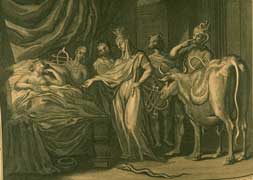.

Isis, 2nd c. BC, Dion Museum, Greece
Isis is a goddess in the Egyptian belief. She was most prominent mythologically as the wife of Horus, or, in later periods, as the wife of Osiris and mother of Horus, and was worshipped as the archetypal wife and mother.
Her name literally means (female) of throne, i.e. Queen of the throne, and the emblem worn on her head was that of a throne. However, the hieroglyph for her name used originally meant (female) of flesh, i.e. mortal, and she may simply have represented deified, real, queens.
Her origins are uncertain but are believed to come from the Nile Delta; however unlike other Egyptian deities she did not have a centralised cult at any point throughout her worship. First mentions of Isis date back to the 5th dynasty, but her cult became prominent late in Egyptian history, when it began to absorb the cults of many other goddesses. It eventually spread outside Egypt throughout the Middle East and Europe, with temples to her built as far away as the British Isles. Pockets of her worship remained in Christian Europe as late as the 6th century.
Name and pronunciation

Isis in hieroglyphs
The most commonly used name for this deity, Isis, is a Greek corruption of the Egyptian name; and its pronunciation as eye-sis is a further corruption by English speakers. The true Egyptian pronunciation is unknown, as Egyptian hieroglyphs only recorded consonants, and left out most of the vowels. The Egyptian hieroglyphics for her name are commonly transliterated as jst; as a convenience, Egyptlogists pronounce that as ee-set, however they realize it has nothing to do the actual pronunciation. The name was pronounced as (?)-vowel(?)-s-vowel-t (with ? representing the glottal stop), and the actual vowels, as well as the sounds of the consonants, have likely fluctuated throughout 3,000 years of the Egyptian language's spoken history.
Worship
Temples
Most Egyptian deities started off as strictly local, and throughout their history retained local centers of worship, with most major cities and towns widely known as the hometowns to their deities. However, no traces of local Isis cults are found; throughout her early history there are also no known temples dedicated to her. Individual worship of Isis does not begin until as late as the 30th dynasty; until that time Isis was depicted and apparently worshipped in temples of other deities. However, even then Isis is not worshipped individually, but rather together with Horus and Osiris. Temples dedicated specifically to Isis become wide-spread only in the Roman times.
By this period, temples to Isis begin to spread outside of Egypt. In many locations, particularly Byblos, her cult takes over that of worship to the Semitic goddess Astarte, apparently due to the similarity of names and associations. During the Hellenic era, due to her attributes as a protector, and mother, and the lusty aspect originally from Hathor, she was also made the patron goddess of sailors.
Throughout the Graeco-Roman world, Isis becomes one of the most significant of the mystery religions, and many classical writers refer to her temples, cults and rites. Temples to Isis were built in Iraq, Greece, Rome, even as far north as England where the remains of a temple were discovered at Hadrian's Wall. At Philae her worship persisted until the 6th century, long after the wide acceptance of Christianity.
Priesthood
Little information on Egyptian priests of Isis survives; however it is clear there were both male and female priests of her cult throughout her early history. By the Graeco-Roman era, all priestesses of Isis are female. Many of them were healers and midwives, and were said to have many special powers, including dream interpretation and the ability to control the weather by braiding or combing their hair, the latter of which was because the ancient Egyptians considered knots to have magical power.
Iconography
Associations

"tyet" – Knot of Isis in hieroglyphs
Because of the association between knots and magical power, a symbol of Isis was the tiet/tyet (meaning welfare/life), also called the Knot of Isis, Buckle of Isis, or the Blood of Isis. The tiet in many respects resembles an ankh, except that its arms curve down, and in all these cases seems to represent the idea of eternal life/resurrection. The meaning of Blood of Isis is more obscured, but the tyet was often used as a funerary amulet made of red wood, stone, or glass, so this may have simply been a description of its appearance.
The star Spica (sometimes called Lute Bearer), and the constellation which roughly corresponded to the modern Virgo, appeared at a time of year associated with the harvest of wheat and grain, and thus with fertility gods and goddesses. Consequently they were associated with Hathor, and hence with Isis through her later conflation with Hathor. Isis also assimilated Sopdet, the personification of Sirius, since Sopdet, rising just before the flooding of the Nile, was seen as a bringer of fertility, and so had been identified with Hathor. Sopdet still retained an element of distinct identity, however, as Sirius was quite visibly a star and not living in the underworld (Isis being the wife of Osiris, king of the underworld).
Titles
In the Book of the Dead Isis was described as She who gives birth to heaven and earth, knows the orphan, knows the widow, seeks justice for the poor, and shelter for the weak. Some of Isis' many other titles were Queen of Heaven, Mother of the Gods, The One Who is All, Lady of Green Crops, The Brilliant One in the Sky, Star of the Sea, Great Lady of Magic, goddess of magic, fertility, nature, motherhood,and underworld Mistress of the House of Life, She Who Knows How To Make Right Use of the Heart, Light-Giver of Heaven, Lady of the Words of Power, and Moon Shining Over the Sea.
Depictions
In art, originally Isis was pictured as a woman wearing a long sheath dress and crowned with the hieroglyphic sign for a seat, sometimes holding a lotus, as a sycamore tree. After her assimilation of Hathor, Isis's headdress is replaced with that of Hathor: the horns of a cow on her head, and the solar disc between them. She was also sometimes symbolised by a cow, or a cow's head. Usually, she was depicted with her son, the great god Horus, with a crown and a vulture, and sometimes as a kite bird flying above Osiris's body.
Isis is most often seen holding only the generic ankh sign and a simple staff, but is sometimes seen with Hathor's attributes, the sistrum rattle and the crescent moon shaped menat necklace.
Mythology
Early Isis

Isis in hieroglyphs
Throne queen
As the deification of the wife of the pharaoh, the first prominent role of Isis was as the assistant to the deceased king. Thus she gained a funerary association, her name appearing over 80 times in the Pyramid Texts, and was said to be the mother of the four gods who protected the canopic jars - more specifically, Isis was viewed as protector of the liver-jar-god Imsety. This association with the Pharaoh's wife also brought the idea that Isis was considered the spouse of Horus, who was protector, and later the deification, of the Pharaoh himself. Consequently, on occasion, her mother was said to be Hathor, the mother of Horus. By the Middle Kingdom, as the funeral texts spread to be used by non-royals, her role also grows to protect the nobles and even the commoners.
By the New Kingdom, Isis gains prominence as the mother / protector of the Pharaoh. She is said to breastfeed the pharaoh with her milk, and is often depicted visually as such. The role of her name and her throne-crown is uncertain. Some egyptologists believe that being the throne-mother was Isis' original function, however a more modern view states that aspects of the role came later by association. In many African tribes, the king's throne is known as the mother of the king, and that fits well with either theories, giving us more insight into the thinking of Ancient Egyptians.
Sister-wife to Osiris
In another area of Egypt, when the pantheon was formalised, Isis became one of the Ennead of Heliopolis, as a daughter of Nuit and Geb, and sister to Osiris, Nephthys, and Set. As a funerary deity, she was associated with Osiris, god of the underworld (Aaru), and thus was considered his wife. The two females - Isis and Nephthys were often depicted on coffins, with wings outstretched, as protectors against evil.
A later legend, ultimately a result of the replacement of another god of the underworld when the cult of Osiris gained more authority, tells of the birth of Anubis. The tale describes how Nephthys became sexually frustrated with Set, who was gay (and already had a male lover - Shu), and so disguised herself as the much more attractive Isis to try to seduce him. The ploy failed, but Osiris now found Nepthys very attractive, as he thought she was Isis. They coupled, resulting in the birth of Anubis. In fear of Set's anger, Nephthys persuaded Isis to adopt Anubis, so that Set would not find out. The tale describes both why Anubis is seen as an underworld deity (he is a son of Osiris), and why he couldn't inherit Osiris' position (he was not a legitimate heir), neatly preserving Osiris' position as lord of the underworld.
Assimilation of Hathor
Beliefs about Ra himself had been hovering around the identification of Ra, a sun god, with Horus, another sun god (as the compound Ra-Herakhty), and so for some time, Isis had intermittently been considered the wife of Ra, since she was the wife of Horus. Consequently, since there was not anything logically troubling by identifying Isis as Ra's wife, Hathor unlike identifying Ra as his own son, she and Hathor became considered the same deity, Isis-Hathor. Sometimes the alternative consideration arose, that Isis, in the Ennead, was a child of Atum-Ra, and so should have been a child of Ra's wife, Hathor, although this was less favoured as Isis had enough in common with Hathor to be considered one and the same.
Mother of Horus

Isis nursing Horus
It was this merger with Hathor that proved to be the most significant event in the history of Egyptian mythology. By merging with Hathor, Isis became the mother of Horus, rather than his Wife, and thus, when beliefs of Ra absorbed Atum into Atum-Ra, it also had to be taken into account that Isis was one of the Ennead, as the wife of Osiris. However, it had to be explained how Osiris, who as god of the dead, was dead, could be considered a father to Horus who was very much not considered dead. This lead to the evolution of the idea that Osiris needed to be resurrected, and so to the Legend of Osiris and Isis, of which Plutarch's De Iside et Osiride contains the most extensive account known today, a myth so significant that everything else paled in comparison.
Yet another set of myths detail the adventures of Isis after the birth of Osiris' posthumous son, Horus. Many dangers faced Horus after birth, and Isis fled with the newborn to escape the wrath of Seth, the murderer of her husband. In one instance, Isis heals Horus from a lethal scorpion sting; she also performs other miracles in relation to the so-called cippi, or the plaques of Horus. Isis protected and raised Horus until he was old enough to face Seth, and subsequentally became the king of Egypt.
Magic
In order to resurrect Osiris for the purpose of having the child Horus, it was necessary for Isis to learn magic, and so it was that Isis tricked Ra (i.e. Amun-Ra/Atum-Ra) into telling her his "secret name", by getting a snake to bite and poison him, so that he would use his "secret name" to survive. This aspect becomes central in magic spells, and Isis is often implored to use the true name of Re while performing rituals. By the late Egyptian history, Isis becomes the most important, and most powerful magical deity of the Egyptian pantheon. Magic is central to the entire mythology of Isis; arguably more so than any other Egyptian deity.
In consequence of her deeply magical nature, Isis also became a goddess of magic. The the prior goddess to hold the quadrupole roles of healer, protector of the canopic jars, protector of marriage, and goddess of magic, Serket, became considered an aspect of her. Thus it is not surprising that Isis had a central role in Egyptian magic spells and ritual, especially those of protection and healing. In many spells, she is also completely even merged with Horus, where invocations of Isis are supposed to automatically involve Horus' powers as well.
Assimilation of Mut
After the authority of Thebes had risen, and made Amun into a much more significant god, it later waned, and Amun was assimilated into Ra. In consequence, Amun's consort, Mut, the doting, infertile, and implicitly virginal, mother, who by this point had absorbed other goddesses herself, was assimilated into Ra's wife, Isis-Hathor, as Mut-Isis-Nekhbet. On occasion, Mut's infertility and implicit virginity, was taken into consideration, and so Horus, who was too significant to ignore, had to be explained by saying that Isis became pregnant with magic, when she transformed herself into a kite and flew over Osiris' dead body.
Mut's husband was Amun, who had by this time become identified with Min as Amun-Min (also known by his epithet - Kamutef). Since Mut had become part of Isis, it was natural to try to make Amun, part of Osiris, the husband of Isis, but this was not easily reconcilable, because Amun-Min was a fertility god and Osiris was the god of the dead. Consequently they remained regarded separately, and Isis was sometimes said to be the lover of Min. Subsequently, as at this stage Amun-Min was considered an aspect of Ra (Amun-Ra), he was also considered an aspect of Horus, since Horus was identified as Ra, and thus Isis' son was on rare occasions said to be Min instead, which neatly avoided having confusion over Horus's status as was held at being the husband and son of Isis.
Isis outside Egypt
The cult of Isis rose to prominence in the Hellenistic world, beginning in the last centuries BC, until it was eventually banned by the Christians in the 6th century. Despite the Isis mystery cult's growing popularity, there is evidence to suggest that the Isis mysteries were not altogether welcomed by the ruling classes in Rome. Her rites were considered by the princeps Augustus to be "pornographic" and capable of destroying the Roman moral fibre.
Tacitus writes that after Julius Caesar's assassination, a temple in honour of Isis had been decreed; Augustus suspended this, and tried to turn Romans back to the Roman gods who were closely associated with the state. Eventually the Roman emperor Caligula abandoned the Augustan wariness towards Oriental cults, and it was in his reign that the Isiac festival was established in Rome. According to Josephus, Caligula himself donned female garb and took part in the mysteries he instituted, and Isis acquired in the Hellenistic age a "new rank as a leading goddess of the Mediterranean world."
Roman perspectives on cult were syncretic, seeing in a new deity merely local aspects of a familiar one. For many Romans, Egyptian Isis was an aspect of Phrygian Cybele, whose orgiastic rites were long naturalized at Rome, indeed she was known as Isis of Ten Thousand Names. In the Golden Ass (1st century), Apuleius' goddess Isis is identified with Cybele:
Behold, Lucius, I have arrived. Thy weeping and prayers have moved me to succour thee. I am she that is the natural mother of all things, the Mistress and Governess of all the Elements, the initial Progenitrix of all things, the Chief of powers divine, Queen of Heaven, the First of the Gods celestial, the light of the Goddesses. At my will, the planets of the air, the wholesome winds of the Seas, and the silences of hell are disposed; my name, my divinity is adored throughout all the world in various manners, in various customs and in many names, for the Phrygians call me the Mother of the Gods.
Among these names of Roman Isis, Queen of Heaven is outstanding for its long and continuous history. Herodotus identified Isis with the Greek and Roman goddesses of agriculture, Demeter and Ceres. In Yorùbá mythology, Isis became Yemaya. In later years, Isis also had temples throughout Europe, Africa, and Asia, and as far away as the British Isles, where there was a temple to Isis on the River Thames by Southwark.
Links to Christianity

One of these two images is a famous mediaeval icon of Mary and Jesus, the other is a bronze statue of Isis nursing Horus dating from the Ptolomeic era of Egypt
Some scholars argue that aspects of Isis worship have influenced the practices of some Christians in regard to the Virgin Mary, and especially her relationship with her son, Jesus. There is a strong resemblance to the depiction of the seated Isis holding or suckling the child Horus and the seated Mary and the baby Jesus. It has been suggested by these scholars that the reason Isis worship abruptly ends, despite the vast number of its adherents, is due to her having been identified as Mary, and her temples having been merely renamed in consequence. If this is true then it could be said that, in a way, Isis is still worshipped today, and has been for at least 5000 years.
Many Egyptologists however disagree with the claims, stating that by the time the cult of Virgin Mary arose, the worship of Isis has greatly evolved from the Egyptian myths, and her relationship with Horus was no longer a major factor. These egyptologists consider that the goddess whose worship was replaced by Chritianity was a merged Isis-Aphrodite hybrid, with sexuality and magical aspects much more important to the cult. By this time she was almost never depicted as a mother with baby; she was mostly depicted alone, often lifting her dress to expose her genitals. Nethertheless, the resemblence between early christian images of Mary and those of Isis are sometimes striking, providing an explanation for the somewhat awkward position of Mary's arm - breastfeeding that was later censured by the addition of clothing.

References
- Richard H. Wilkinson (2003), The Complete Gods and Goddesses of Ancient Egypt.
- Spence, Lewis (1990), Ancient Egyptian Myths and Legends.
- Shaw, Ian (2000), The Oxford History of Ancient Egypt.
- Shaw, Ian (195), The British Museum Dictionary of Ancient Egypt.
- Rosalie David, (1998) Handbook to Life in Ancient Egypt.
See also Harpocrates (Companison of Isis)
Isis Sanctuary in Dion, Greece
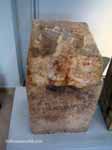
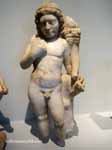
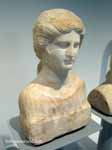

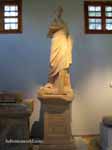
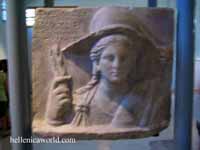

7,

A Night-Time Ceremony before the Temple of Isis. Pompeii, Louis Jean Desprez
See also : Greek Mythology. Paintings, Drawings
| Ancient Greece
Science, Technology , Medicine , Warfare, , Biographies , Life , Cities/Places/Maps , Arts , Literature , Philosophy ,Olympics, Mythology , History , Images Medieval Greece / Byzantine Empire Science, Technology, Arts, , Warfare , Literature, Biographies, Icons, History Modern Greece Cities, Islands, Regions, Fauna/Flora ,Biographies , History , Warfare, Science/Technology, Literature, Music , Arts , Film/Actors , Sport , Fashion --- |
Retrieved from "http://en.wikipedia.org"
All text is available under the terms of the GNU Free Documentation License



